Campus of the University of Notre Dame
The Campus of the University of Notre Dame is located in Notre Dame, Indiana, spans 1,250 acres, and comprises around 170 buildings. The campus is consistently ranked among the most beautiful campuses in the country.[1][2][2][3]
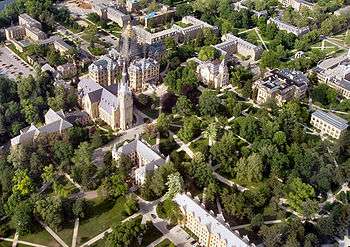
The center of campus is Main Quad, often called God Quad, which hosts the Main Building and the Basilica, and other important buildings and residence halls. The North-West area of campus is mainly dedicated to residential buildings, the Central-East portion of campus is dedicated to academic spaces, while the South-East is dedicated to athletics. A part from Main Quad, there are 6 quadrangles: North Quad, Mod Quad, and West Quad (mainly residential), South Quad and Bond Quad (mixed residential and academic), and DeBartolo Quad (only academic).[4][5]
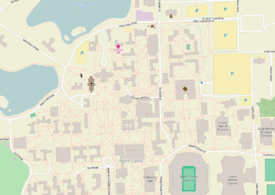
Surroundings
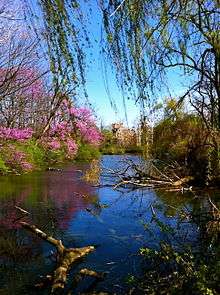
The University of Notre Dame is located in Notre Dame, Indiana, a census designated place near South Bend and Mishawaka, in the Michiana region. It is 5 miles south of the Indiana-Michigan border.
The Lakes
The campus contains two lakes, with give it its name (Notre Dame du lac meaning "Our Lady of the lake"), St. Mary's lake and St. Joseph's lake. St. Joseph's Lake has a small beach and pier for swimming and a boating facility for student use. There has been speculations on the fact that the name of the University references a single lake instead of two[6]
Eddy Street Commons
Eddy Street Commons is a mix-used development that opened in the summer of 2009. It hosts venues, businesses, services, and apartment complexes that make it a small college town for the University.[7]
Cemeteries
The University campus is home to two cemeteries, one reserved for members of the Congregation of Holy Cross, and the other open to the general public.
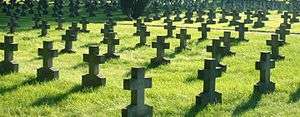
Holy Cross Cemetery is reserved for members of the Congregation of Holy Cross, which founded the University. All burials are identical and composed by a simple stone cross with the name of the deceased and his dates. Burials include Rev. Edward Sorin, Rev. William Corby, Fr. John Zahm, Rev. Theodore Hesburgh. All but one of Notre Dame’s 14 deceased presidents are buried in the community cemetery. The exception is Cardinal John O’Hara, CSC; the order’s first and only cardinal, he is now entombed inside the Basilica. Cedar Grove Cemetery was established in 1843 by Rev. Edward Sorin, soon after he founded the University. . Burials include Dave Duerson, Moose Krause, Ray Lemek, and Ralph McInerny. The brothers of the congregation also established a mortuary, one of the first in Indiana.[8] Throughout the 19th and 20th centuries it was a Catholic cemetery open to the public. In 1977 ownership was transferred from the Congregation to the University. At this time it became a private cemetery, and burials were reserved for Notre Dame faculty, staff, and retirees with the requisite years of service. Despite recent expansions that brought it to 22 acres, space is very limited. In response to persistent requests, in recent years it has been opened to Notre Dame alumni with the creation of four mausoleums complexes.
Buildings
The Notre Dame campus is composed of around 190 buildings, divided in Quads. Main Quad is at the center, North Quad and Mod Quad are at the north, while South, West and DeBartolo Quads are in the south.
Administration

The Main Building houses various offices, including the Office of the President and admissions. It was built in 1879, after the previous main building, built in 1865, was destroyed by a fire. Construction started May 17 and was finished by the start of the following academic year. The architect was the American Willoughby J. Edbrooke, principally devoted to the Romanesque style, that is reflected in the design of the building itself. Fifty-six bricklayers and 4,350,000 bricks were necessary to complete it, and once finished it stood 187 feet tall.[9] The building also houses the Columbus Murals, a group of large paintings by Italian painter and Notre Dame professor Luigi Gregori, depicting the discovery of the New World by Christopher Columbus. Gregori also painted with figures representing Religion, Philosophy, Science, History, Fame, Poetry and Music the interior of the Golden Dome, the University most recognizable landmark.[10][11] It was gilded in gold in 1886 and crowned with a 19 feet tall statue of "Our Mother", the namesake of the university. The statue was designed and furnished by the girls of the nearby St. Mary's College, and it is a replica of the statue of Mary in Piazza di Spagan in Rome, erected by Pius IX.[10][12]
Flanner Hall and Grace Hall, are two 11-stories high buildings that were initially part of a planned complex of five high-rise buildings, yet were the only two to be actually constructed. They were male residence halls until 1997, when the residence were moved to newly created Knott and O'Neill Halls. The offices housed in these two buildings include the Career Center and Card services, and many other offices of administration. Flanner Hall also houses a chapel dedicated to Saint Andre Bessette,CSC, the first saint of the Congregation of the Holy Cross. A "#1" neon sing is placed atop of Grace Hall, and lit when the Fighting Irish win the Football Championship.[13][14]
Located on South Quad in front of the dining hall, the Coleman Morse Center was built in 2001 and serves mainly administrative purposes, although there are seven classrooms and praying spaces. It includes the offices of the First Year of Studies, Campus Ministries, and Academic Service for Student Athletes.[15] The main hall features a Kugel Fountain, which contains a 13,000 pound granite ball. It was built on the previous site of the Hammes Notre Dame Bookstore.[16]

Carole Sandner Hall was named after Carole Sanders, mother of seven foster children, from Lake Buff after being donated as a gift from her husband. It replaces the previous convent of the Sisters of the Holy Cross.[17] The building costed $11.5, and houses the Alliance for Catholic Education. a volunteering program that prepares college students to serve in Catholic and parochial schools in the US.[18] The program was founded in 1993 by Fathers Timothy Scully and Sean McGraw and serves dioceses in need over the country by providing education to lower income families.[19] The building is enviornemtneal friendly and was awarded the LEED Gold certification.[20] It encloses a cloister garden that recalls the former convent of the Holy Cross novitiate.[21]
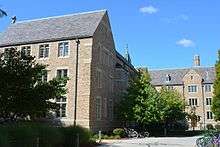
Student Health services are hosted in St. Liam Hall. The first University infirmary was destroyed in the great fire of 1879, and rebuilt the same year in the same spot behind Main Building. This structured survived until 1936, when it was razed to build the current structure. The present hall was built as the Notre Dame Student Infirmary in the spring of 1936, and designed by the Boston architecture firm of Maginnis and Walsh in the Collegiate-Gothic style structure.[22][23] Construction started 27 May 1935 and the building was finished 14 April 1936. The infirmary, the largest of its kind in the country, contained 100 rooms, including five wards and twenty-four private rooms that could accommodate 125 patients. The Sisters of the Holy Cross and two physicians staffed the infirmary.[24] In 2007 Mr and Mrs William K. Warren, Jr., donated $8 million to the University of Notre Dame for the refurbishment of the health center, which was renamed Saint Liam Hall. The Warrens are prominent donors to the University of Notre Dame; the Notre Dame golf course is called the Warren Golf Course. The university stated the building was named in honor of Mr. Warren's father William K. Warren, Sr. (Liam is Irish for William) and his namesake Saint William of York.[25]
Academic buildings
Hesburgh Library
The Hesburgh Library is the primary building of the library system of the University of Notre Dame. The building opened on September 18, 1963, as the Memorial Library. It was named after Father Theodore Hesburgh in 1987. The library has 3.39 million volumes, the 61st largest collection among all U.S. research universities.The future of Hesburgh Library
Law School
The first Law School building was built in 1930. In 2004, the Kresge Law Library became one of the few academic law libraries to own more than 600,000 volumes. This was accomplished mainly under the tenure of the fifth law librarian, Roger Jacobs, who also served as head librarian of the Library of the United States Supreme Court. Between 2007 and 2008, a major expansion was added as the Eck Hall of Law, with 85.000 square feet of surface. In 2010 Robert Biolchini, alumnus, funded the renovation of the Kresge Law Library, that was renamed Biolchini Hall of Law. The renovated Biolchini Hall has surface of 106,500 square feet (for a total of 192,500 with Eck Hall of Law), two 50-seat class, a seminar room, 29 group study rooms, and hosts 300,000 book volumes and more than 300,000 volumes in microfilm. The total cost of renovations and expansions was approximately 58 million dollars.
Mendoza College of Business
O'Shaughnessy Hall
Built in 1953, this classroom building is the main center of the Notre Dame College of Arts and Letters, hosting classrooms, art galleries, administrative offices. It was featured in the movie Rudy.[26]
Bond Hall
Originally built in 1917 as the University Library, it is today the home of the Notre Dame School of Architecture. It is the only building built in Renaissance style, and one of the two building in stone.[27]
Religious buildings
Basilica of the Sacred Heart
Originally known as Sacred Heart Parish, the Basilica of the Sacred Heart also serves as the mother church of the Congregation of Holy Cross in the United States. The neo-gothic church has 44 large stained glass windows and murals completed over a 17-year period by the Vatican painter Luigi Gregori. The basilica bell tower is 218 feet (66 m) high, making it the tallest University chapel in America.
Grotto of Lourdes
Built in 1896, the Grotto is reproduction of the Grotto of Our Lady of Lourdes.
Residential halls
There are currently 29 undergraduate residence halls at the University of Notre Dame. Each residence hall is single sex, with 15 all-male residence halls and 14 all-female residence halls.[28] All first-year students are not only guaranteed on-campus housing, but are required to reside on-campus for at least one semester. Many of the halls were inserted in 1973 on the National Register of Historic Places.[29][30] Notre Dame has a unique undergraduate hall system, where students rarely switch dorms and each dorms builds its own spirit, tradition, mascot, sport teams, events, dances and reputation. Approximately 80% of undergraduate students live on-campus, and generally a student usually resides in the same dorm for the entirety of their undergraduate career. A huge segment of student life happens though residence halls and students develop a particular attachment to their undergraduate hall. Each residence hall is directed by with one Rector with the assistance of two Assistant Rectors and a variable number of Resident Assistants (from 4 to 9). Every residence hall has a chapel where Mass is held, fields a variety of intramural sports teams, elects one senator to represent the dorm in Student Government, and elects co-presidents which work through the Hall Presidents Council (HPC) student organization.
Museums
Snite Museum of Art
The Snite Museum of Art is a fine art museum on the University of Notre Dame campus, near South Bend, Indiana. It owns over 23,000 works which represent many principal world cultures and periods, with a focus on Western art history.[31] It is particularly known for its Italian Renaissance paintings[32] and their Mesoamerican galleries. According to the website, ..."the museum now exhibits the most important collection of Olmec art in any art museum in the United States. The Unruh purchase reinforces the Museum's position as one of the most important general pre-Columbian collections in this country."[33]
Recreational facilities
Washington Hall
LaFortune Student Center
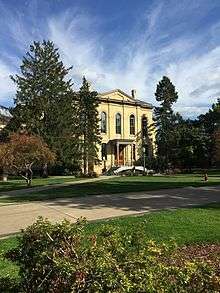
A Science Hall was built in 1883 under the direction of Fr. Zahm, but in 1950 it was converted to a student union building and named LaFortune Center, after Joseph LaFortune, an oil executive from Tulsa, Oklahoma. Commonly known as "LaFortune" or "LaFun," it is a 4-story building of 83,000 square feet[34] that provides the Notre Dame community with a meeting place for social, recreational, cultural, and educational activities.[35] LaFortune employs 35 part-time student staff and 29 full-time non-student staff and has an annual budget of $1.2 million.[34] Many businesses, services, and divisions of The Office of Student Affairs[35] are found within. The building also houses restaurants from national restaurant chains.[36]
Legends of Notre Dame
Athletic facilities
Notre Dame Stadium
The Notre Dame Stadium is an outdoor football stadium, home field of the University of Notre Dame Fighting Irish. Opened 86 years ago in 1930, the stadium seating capacity was nearly 60,000 for decades. More than 21,000 seats were added for the 1997 season, which increased the capacity to over 80,000. The playing surface was changed to FieldTurf in 2014, after 84 seasons on natural grass. The stadium is undergoing a 400 million dollars expansion project.[37]
Joyce Center and Purcell Pavilion
The Edmund P. Joyce Athletic & Convocation Center, often called the Joyce Center, is a 9,149-seat multi-purpose arena. The arena opened in 1968. It is home to the University of Notre Dame Fighting Irish basketball and volleyball teams. The main arena, Phillip J. Purcell Pavilion, is located in the southern portion of the facility. The northern portion housed a hockey rink until October 2011. It also houses the Rolfs Aquatic Center (which was added on in 1985) in the rear of the building.
Compton Family Ice Arena
The Compton Family Ice Arena is a 5,022-seat, two-rink ice facility. The arena saw its first game on October 21, 2011. The ice arena replaced the 2,857-seat rink in the north dome of the Edmund P. Joyce Center.
Art and monuments
Christ the Life Touchdown Jesus
The side of the library facing the stadium is covered a 134 feet high and 68 feet wide mural called "The Word of Life", and commonly known as "Touchdown Jesus".
Statue of Fr.Sorin

God Quad hosts a statue of Fr. Sorin, the Founder of the University.[38] Sculpted by Ernesto Biondi in 1906. it is over 20 feet tall. it includes a Latin inscription.
| Cyrillic | English Translation |
| D.O.M. |
To God, Greatest and Best. |
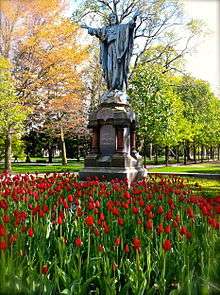
Venite ad Me Omnes
The statue represents the Sacred Heart of Jesus.
It was sculpted by Robert Cassiani and dedicated during the 1893 commencement exercises. it represents Jesus and the inscription translates to "Come to me everyone".
It faces the lady on the golden dome. It underwent restoration in 2013.[39]
Clark Memorial Fountain

Modeled after Stonehenge, it is a peace monument commemorating around 500 Notre Dame alumni who died in World War II, the Korean conflict, and Vietnam. The names of those wars are carved in three of its arches, and the fourth arch bears the Latin inscription Pro Patria et Pace, "For Country and Peace." It was designed in 1983 by architects John Burgee (alumnus of the University) and Philip Johnson. It was dedicated in 1986, the fountain was underwritten by Notre Dame alumnus Thomas Shuff and by its principal benefactor, Maude Clarke of Chicago. Mrs. Clarke's donation was made in memory of her husband John, an investment banker who once served on the business college's advisory council. Both of the Clarkes had also been Army officers in World War II.
The Fountain is the centerpiece of Fieldhouse Mall, a park-like area with benches and formal gardens that graces the southern end of the quad. The mall serves as a crossway between Hesburgh Library and the Main Quad, but is also a popular place for festivals, social activities, and marching band rehearsals. The site was created when the Old Fieldhouse was torn down in 1983, and consistent with Notre Dame's steadfast sense of tradition, there now stands a buff brick monument to that long-gone gymnasium.
Statue of Rev.Corby
A statue of President Corby stands in front of Corby Hall. Corby served as chaplain of the Irish Brigade during the battle of Gettysburg. Hence, an identical statue is present at Gettysburgh.[40]
The statue is attributed the football nickname "Fair Catch Corby".
Saint Edward the Confessor
It was created by Froc-Robert & Sons in 1880. It was installed in 1883, gift of the Sorin association. St. Edward was the patron saint of Father Sorin. The statue is made of bronze and is tall approximately 7 feet tall.
The statue holds a scepter and a small church, reminiscent of the campus basilica.
Moses

Locate outside the west entrance of Hesburgh Library, it was created by Joseph Turkalji in 1962. His foot stands on the neck of a calf, and his right hand index finger points to the sky. It represents a passage from Exodus.
As many Notre Dame statues, Moses has a double meaning regarding American football. he is either known as 'First Down Moses' of 'Number #1 Moses'. The horns of the head of Moses are probably referring to one of the most famous depictions of Moses in sculpture, the statue by Michelangelo.
Christ and the Samaritan Woman
The sculpture featured is found gracing the western entrance of O'Shaughnessy Hall, the home of the College of Arts and Letters. It was executed in 1957 by the Croatian sculptor Ivan Mestrovic, who was in residence at Notre Dame from 1955 until his death in 1962, on the model of a sculpture he had completed in wood relief thirty years earlier for a chapel in his native town of Split, Croatia. The Notre Dame sculpture, which depicts the Samaritan woman's gradual recognition of Jesus as the Savior as narrated in John 4:1-42, is full of expressive gesture that conveys the drama and subtle nuances of their communication.
The statue is part of a memorial that includes benches, trees, and the statues of St. John and the prophet Isaiah.
References
- ↑ http://www.thebestcolleges.org/most-beautiful-campuses/
- 1 2 http://www.travelandleisure.com/articles/americas-most-beautiful-college-campuses/4
- ↑ http://structurehub.com/blog/2009/09/americas-ten-most-beautiful-college-campuses/
- ↑ http://housing.nd.edu/undergraduate/facility-room/housing-quadrangles/
- ↑ http://www.collegerank.net/beautiful-campus-quads/
- ↑ http://magazine.nd.edu/news/10614-one-lake-or-two/
- ↑ http://tour.nd.edu/locations/eddy-street-commons/
- ↑ http://cemetery.nd.edu/about-cedar-grove/
- ↑ http://tour.nd.edu/locations/the-main-building/
- 1 2 http://articles.chicagotribune.com/2004-09-26/travel/0409250216_1_edward-sorin-campus-golden-dome
- ↑ http://www.conradschmitt.com/portfolio/projects/?projectID=28
- ↑ http://archives.nd.edu/hope/hope13.htm
- ↑ http://magazine.nd.edu/news/10068-hall-portrait-flanner/
- ↑ http://magazine.nd.edu/news/10011-hall-portrait-grace/
- ↑ http://facilities.nd.edu/coleman-morse-center/
- ↑ http://www.kenherceg.com/pdfs/proj5.pdf
- ↑ http://www.triblocal.com/lake-bluff/2011/09/24/university-of-notre-dame-names-academic-building-after-lake-bluff-woman/
- ↑ http://articles.chicagotribune.com/2011-09-28/news/ct-met-notre-dame-first-lady-20110928_1_lake-bluff-woman-jack-sandner-holy-cross
- ↑ http://www.todayscatholicnews.org/2011/09/dedication-of-ace%E2%80%99s-new-home-at-notre-dame/
- ↑ http://news.nd.edu/news/30288-carole-sandner-hall-receives-leed-gold-certification/
- ↑ http://archinect.com/john/project/carole-sandner-hall-university-of-notre-dame
- ↑ http://www.archives.nd.edu/Scholastic/VOL_0069/VOL_0069_ISSUE_0023.pdf
- ↑ http://www.archives.nd.edu/Alumnus/VOL_0014/VOL_0014_ISSUE_0009.pdf
- ↑ http://tomandkatehickeyfamilyhistory.blogspot.com/2014/09/1936-thomas-l-hickey-inc-completed.html
- ↑
- ↑ http://tour.nd.edu/locations/oshaughnessy-hall/
- ↑ http://tour.nd.edu/locations/bond-hall/
- ↑ University of Notre Dame, Office of Residence Life and Housing, http://housing.nd.edu/undergraduate/general-info/facts-figures/
- ↑ "Welcome to SHAARD". Secure.in.gov. Retrieved 2015-12-23.
- ↑ https://secure.in.gov/apps/dnr/shaard/r/1c9d1/N/University_of_Notre_Dame_Campus_Main_and_South_Quadrangles_St._Joseph_CO_Nom.pdf
- ↑ ENR/PAZ // University Communications: Web // University of Notre Dame. "Collections // Snite Museum of Art // University of Notre Dame". Nd.edu. Archived from the original on 2010-11-25. Retrieved 2014-07-10.
- ↑ "Snite Museum of Art". AskART. Retrieved 2014-07-10.
- ↑ ENR/PAZ // University Communications: Web // University of Notre Dame. "Snite Museum of Art // University of Notre Dame". Nd.edu. Archived from the original on 2010-11-25. Retrieved 2014-07-10.
- 1 2 "Union Spotlight: LaFortune Student Center at the University of Notre Dame". Association of College Unions International. September 2008.
- 1 2 "Lafortune Student Center". Student Activities Office. Retrieved November 25, 2009.
- ↑ "Seen and heard on the Notre Dame campus". Notre Dame Magazine. Winter 2006–2007.
- ↑ http://www.chicagotribune.com/sports/college/ct-notre-dame-stadium-renovation-20150825-story.html
- ↑ http://articles.chicagotribune.com/2004-09-26/travel/0409250216_1_edward-sorin-campus-golden-dome
- ↑ http://ndsmcobserver.com/2013/12/expert-restores-statue-of-jesus/
- ↑ http://www.gettysburg.stonesentinels.com/Individuals/Corby-ND.php
